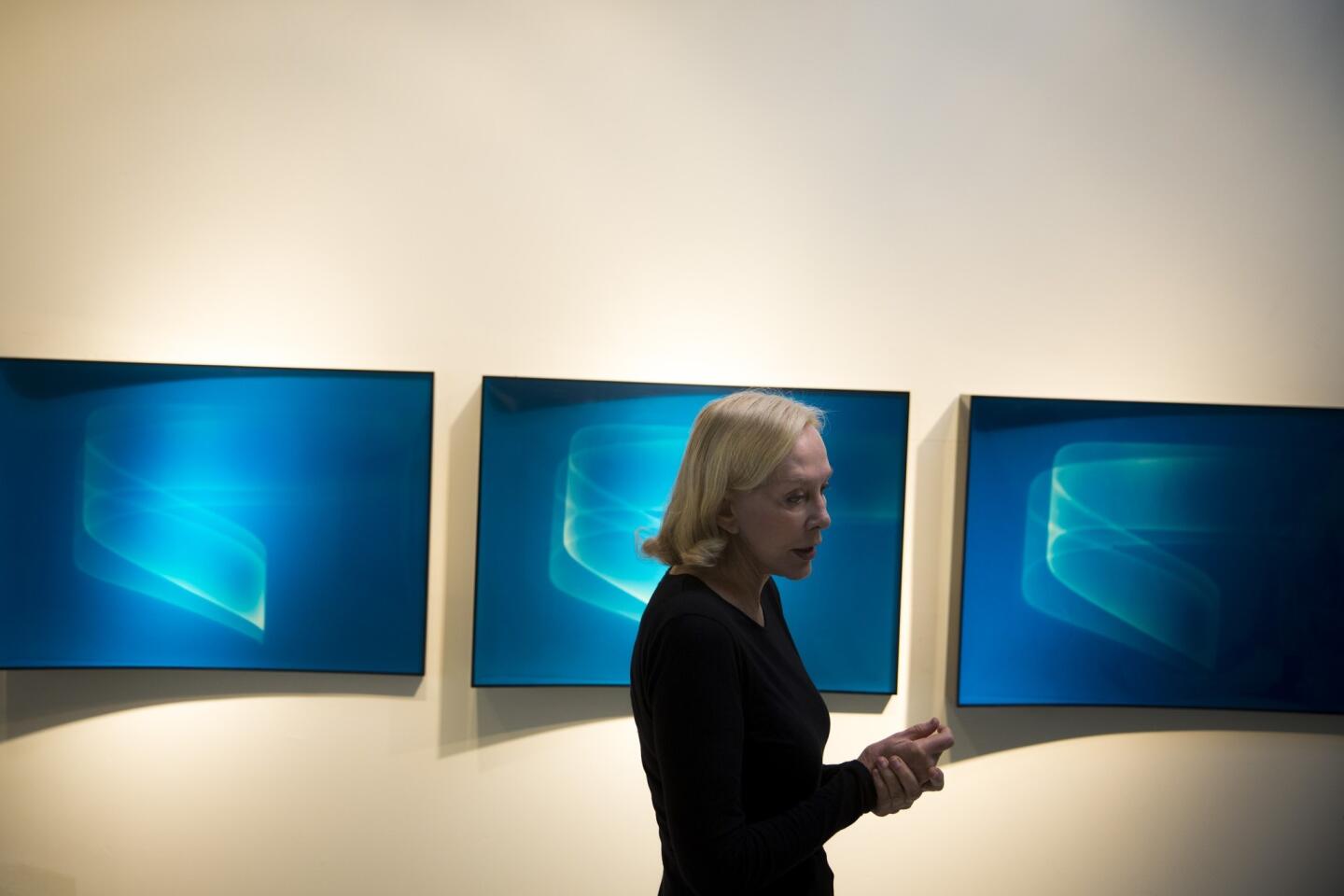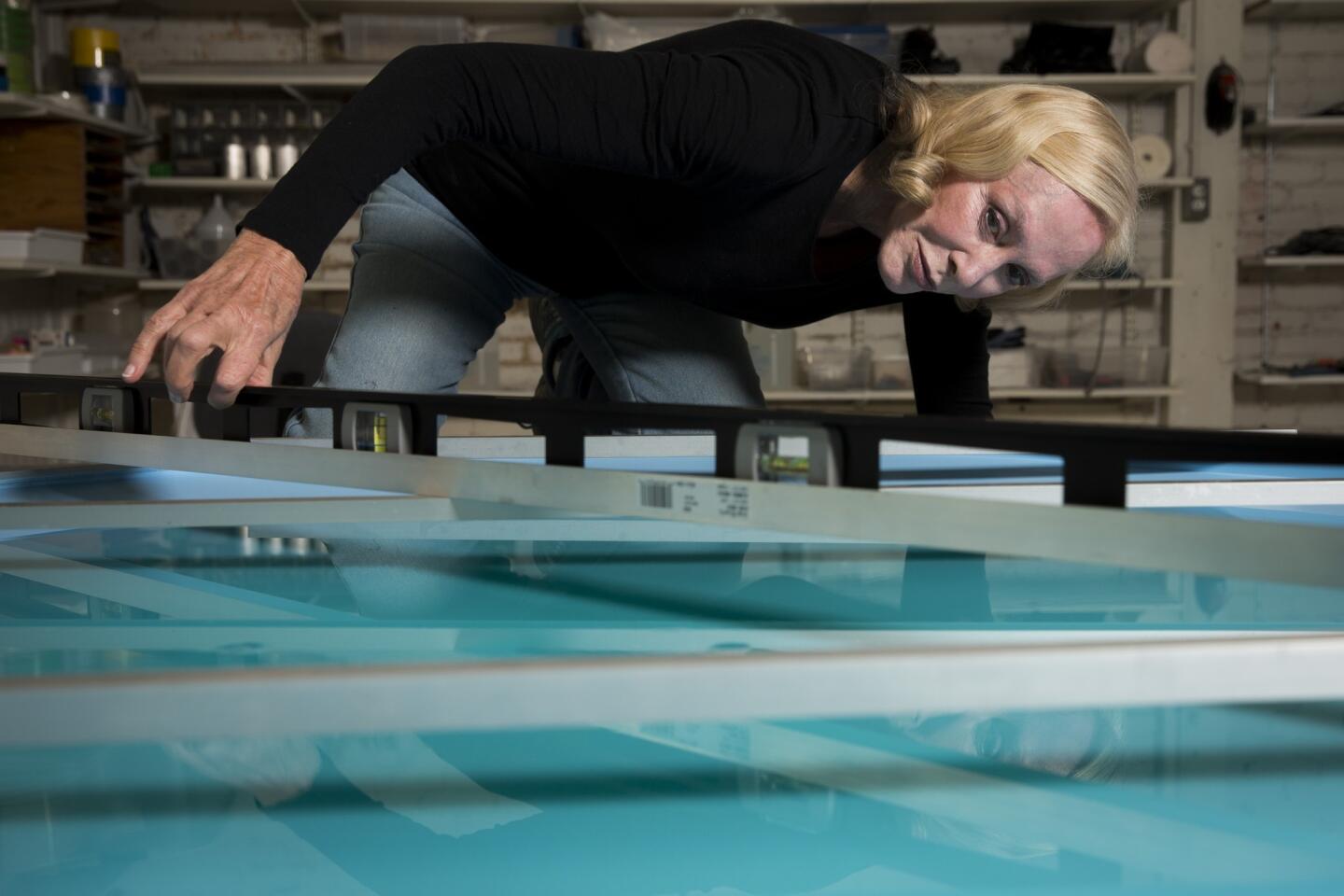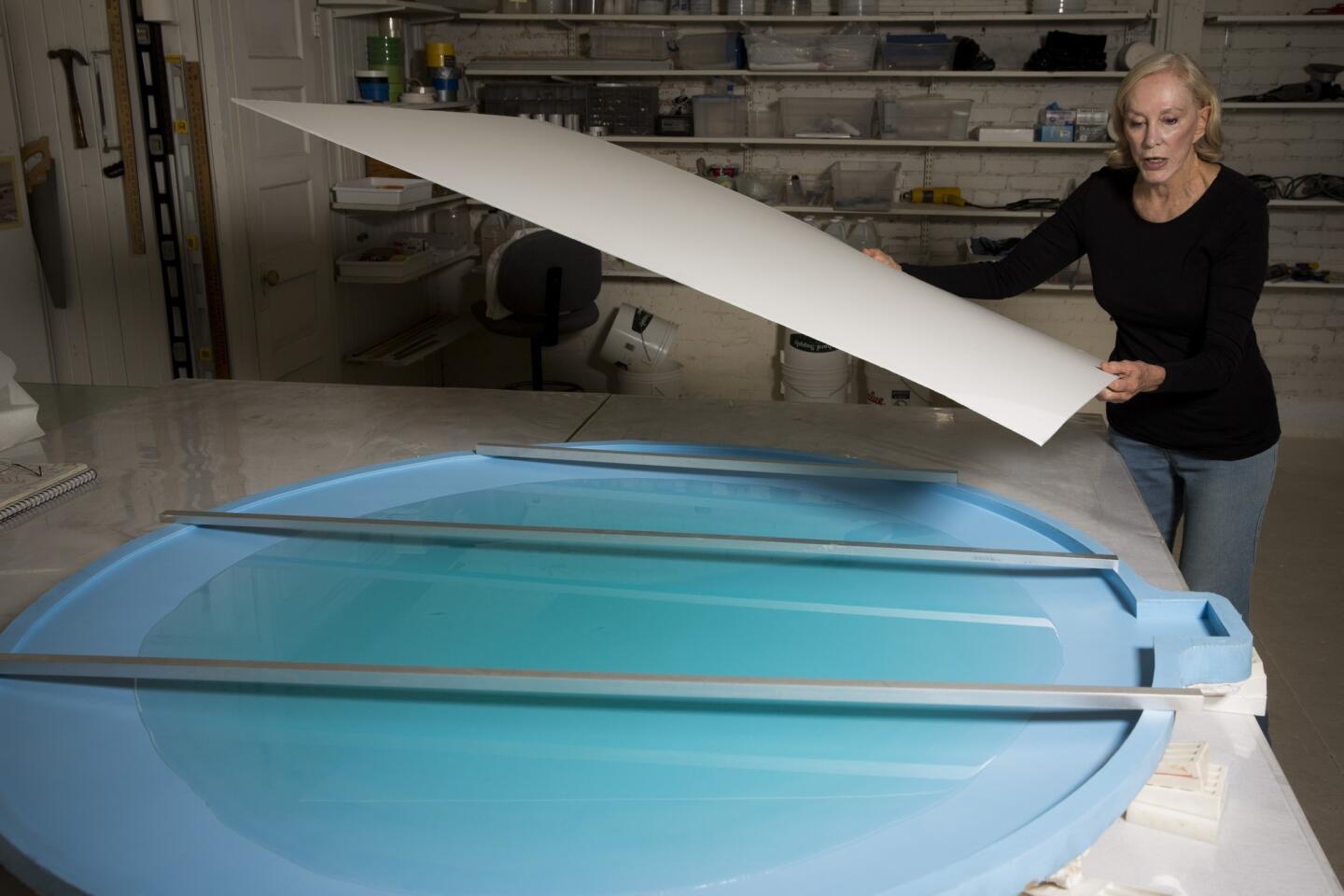Artist Helen Pashgian brings her love of light to LACMA’s space
- Share via
On this dark, drizzly afternoon, one could easily miss Helen Pashgian’s Pasadena art studio, a converted piano warehouse nestled down an alleyway between a parking garage and a coffee house. Except that Pashgian’s brick studio is painted sunny yellow and ocean blue, and it pops against the surrounding blur of concrete and gray sky — a spot of light and levity amid the heavy and the dreary.
The 79-year-old artist, a pioneer of Southern California’s Light and Space movement of the ‘60s and ‘70s, also pops when she appears in the entrance. Tall and athletic-looking in jeans and a plain blue jersey, her platinum blond hair swept elegantly off her face, Pashgian swings open the door with exuberance.
“Come on inside!” she says brightly. “Let’s get this started!”
She leads the way into her creative sanctuary, where she’s tweaking a new installation that goes on view Sunday at the Los Angeles County Museum of Art. At first glance, her studio looks like a carpenter’s work space. Shelves of power tools, plastic safety goggles and coils of orange electrical cord line the walls. A disc-shaped industrial epoxy mold, roughly the size of a car hood, dries on a tabletop, beneath a sheath of white cardboard.
PHOTOS: Best art moments of 2013 | Christopher Knight
“Don’t look under there! Not yet,” Pashgian says in a deep voice, followed by a short chuckle that’s both playful and a bit threatening. “Let’s sit. C’mon.”
Pashgian was one of the few women in a loose group of Southern California artists who coalesced in the late ‘60s, including James Turrell, Larry Bell, Peter Alexander, Robert Irwin and DeWain Valentine. After World War II, these so-called Light and Space artists experimented with materials previously used in the nearby engineering and aerospace industries, such as fiberglass, polyester resin and plastics. The artists bent and twisted these materials, also used to make surfboards and custom cars, into sculptural works that often played with light and perception.
Although Pashgian has shown her work, steadily, in solo and group gallery shows since the ‘60s — she’s currently at L.A.’s Ace Gallery — she didn’t achieve the same widespread recognition as her male contemporaries. She only recently inched into a brighter spotlight as part of the 2011-12 Pacific Standard Time program, where she was in two group exhibitions.
“She’s someone who’s been really overlooked from that period because women were overlooked in the art world then,” Turrell says. “I worked with light and sort of materialized it. Bob Irwin worked with material and de-materialized it into light aspects. Helen was the one who as a sculptor spiritualized the material world. You can sort of materialize the spiritual, but she was coming from the other direction, and I thought that was really interesting and beautiful in her work.”
PHOTOS: The most fascinating arts stories of 2013
“Helen Pashgian: Light Invisible” opens Sunday at LACMA as Pashgian’s first solo show at a major museum. The large-scale installation consists of 12 towering acrylic columns, milky white and translucent, that stand 8 feet high and will run for 120 feet when lined up in the museum’s Art of the Americas Building. The columns illuminate varied shapes inside of them — a floating, jellyfish-like disc, a glowing cube or elongated triangle. They’re elegant and austere, dramatic and sensual — and oddly nuanced, morphing as viewers move around them.
Don’t get personal
Pashgian is equally nuanced. Settled into a folding chair in another room of her studio, she expresses an exuberance for her artwork that is matched only by fleeting bouts of guardedness. She tries to lay down ground rules for the interview: no personal questions. Nothing about her private life — kids, marriage or lack thereof — shall be discussed.
“I’m just private,” she says, shrugging her shoulders. Eventually she confirms she grew up as a third-generation Pasadenan and studied art history at Pomona College. But she won’t talk about family; friends and associates interviewed for this story say they know of no spouses or children. “This interview, it’s about the work,” Pashgian insists.
CHEAT SHEET: Spring arts preview 2014
The artist says she mulled over how to execute the new installation for about 10 years. The columns, not unlike Pashgian herself, are deceptively simple on the outside but house a complex infrastructure. They contain a web of invisible clamps and glue, among other things, to position the interior shapes just so, to cast shards of light and shadows.
To create the columns themselves, Pashgian worked with an industrial fabricator, heating enormous sheets of acrylic into almost fabric-like fluidity, then molding them into two-part columns joined by a fold at the center. She’s shown early incarnations of the design at Ace Gallery and at Pomona College, but the entire installation has never been seen publicly.
It’s a notable departure from Pashgian’s previous work, smaller, three-dimensional pieces that incorporate starker color and are meant to hang on the wall.
“The [works] were gradually becoming more rotund and looking like they wanted to come off the wall,” she says. “These are larger and free-standing. They’re all about mysterious elements that relate to the perception of light.”
PHOTOS: Arts and culture in pictures by The Times
Just the mention of the word “light” and Pashgian’s face softens. It is her inspiration, what drives her to create. “I’m interested in the depth and the light, objects floating in a space that is not defined.”
As she talks, the pitter-patter of raindrops hits the skylight overhead, through which bright, white light spills down onto Pashgian. One of her triptychs from 1990 hangs on a nearby wall — blue waves flowing across glossy tiles. The effect is appropriately aquatic, as the interplay between light and water is another of Pashgian’s inspirations.
“The space where air meets the water, that’s what I’m most interested in — the surface, and below the surface and below that.”
Fully formed by 5
Growing up, Pashgian’s parents would take her to the beach where, at 3 or 4 years old, she’d sit by tide pools for hours, riveted by the light dancing across the water. She’d poke at the shapes underneath the water — shells and rocks and mounds of sand — enthralled by how they reflected and refracted light. Even the long, slow drive to the ocean from Pasadena was marked for her by the warm flashes of light in the citrus trees whizzing by through the car window.
ART: Can you guess the high price?
“Georgia O’Keeffe said that for artists, they were fully formed by the time they were 5 years old. At least in my case, I think that’s true,” she says.
“She’s a very private person,” says Ace Gallery director Douglas Chrismas. “She’s very mysterious and very hesitant to tell you how she does things. But that’s because, I think, she truly feels the art should have its own dialogue with you. That’s part of her magic.”
Pashgian first met Turrell at Pomona College, where she was headed for a career in academia or museum work, she says. While pursuing a PhD at Harvard, Pashgian accidentally transitioned into art-making. She was teaching an applied art class at a high school when she stumbled on transparent ceramic glazes and became fascinated with how they picked up the light. She began experimenting, unsuccessfully, with thick oil paints, then she decided it was time to return home to Southern California.
Why? “The light,” she says. “When I first moved to Boston … the sun didn’t come out for a month. I didn’t realize how depressed I’d gotten by the dark. I finally realized I needed to come home.”
CRITICS’ PICKS: What to watch, where to go, what to eat
Pashgian doesn’t remember the moment that she found the clear resins that made possible her transition to three-dimensional works in the early ‘60s; she likely picked up a sample tube in a craft store, she says. She didn’t have much interaction then with Turrell and “the other guys,” mainly because many of them were based in Venice while she sequestered herself in Pasadena. She wasn’t even aware of a local art movement, per se. Years later, in the late ‘60s and early ‘70s, she says, the artists mixed at gallery openings and appeared together in group shows, but in the earlier days, they crossed paths only briefly, at the Venice work space of fabricator Jack Brogan, who helped many of them engineer unwieldy artworks.
“I had a very active social life, just not with those guys,” Pashgian says. “I was very focused, some might say obsessively so, on the work, and paid little attention to anything else.”
Her relative isolation as one of few women — along with Mary Corse and Maria Nordman — in such a physical art form was not of much consequence, Pashgian says. “I didn’t think about it — and that’s as fully as I’ll answer that.”
Turrell the matchmaker
It was Turrell who first brought Pashgian to LACMA Director Michael Govan’s attention. He introduced the two at a Pomona College dinner in 2007 honoring Turrell for his “Skyspace” installation. Govan followed up with a visit to Pashgian’s studio, and they began talks about an exhibition.
PHOTOS: Celebrities by The Times
“Helen’s work, it is really beautifully ethereal,” Govan says. “The columns are like bodies of light. There are these surprise experiences inside; every way you look at it, they look different. And it makes people move in and around, trying to figure it out. With this show, I think people will realize what an amazing contribution she’s made to the history of art.”
Pashgian balks at the suggestion that a solo museum show is long overdue.
“I do not feel that,” she says. “It’s taken me this period of time to understand how to make this kind of a piece.”
Her hope for what visitors will take away from her installation is equally humble.
“I’m hoping that the presence of these pieces will slow the viewer down,” she says, “so that they’ll look carefully, move around them slowly, for the simple reason that they change. That’s the beauty of light.”
More to Read
The biggest entertainment stories
Get our big stories about Hollywood, film, television, music, arts, culture and more right in your inbox as soon as they publish.
You may occasionally receive promotional content from the Los Angeles Times.














